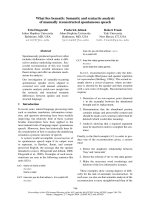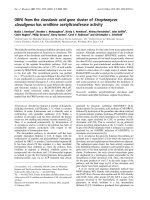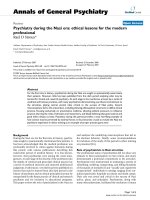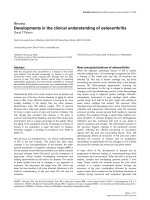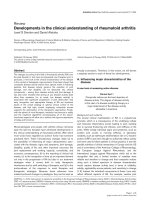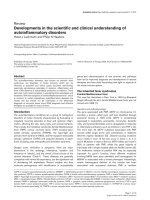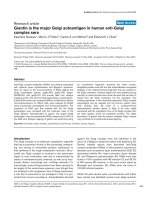Báo cáo y học: "What is the clinical and ethical importance of incidental abnormalities found by knee MRI" docx
Bạn đang xem bản rút gọn của tài liệu. Xem và tải ngay bản đầy đủ của tài liệu tại đây (100.29 KB, 6 trang )
Open Access
Available online />Page 1 of 6
(page number not for citation purposes)
Vol 10 No 1
Research article
What is the clinical and ethical importance of incidental
abnormalities found by knee MRI?
Rebecca Grainger
1,2
, Stephen Stuckey
3
, Richard O'Sullivan
4
, Susan R Davis
5
, Peter R Ebeling
6
and Anita E Wluka
7,8
1
Department of Medicine, Wellington School of Medicine, University of Otago, 23A Mein St, Newtown, Wellington South 6021, New Zealand
2
Malaghan Institute of Medical Research, Kelburn Parade, Wellington 6012, New Zealand
3
Department of Diagnostic Imaging, Southern Health, Clayton Road, Clayton, Victoria, 3168, Australia
4
MRI Unit, Epworth Hospital, 89 Bridge St, Richmond Victoria, 3121, Australia
5
National Health and Medical Research Council of Australia Centre of Clinical Research Excellence for the Study of Women's Health Program,
Department of Medicine, Monash University Medical School, Alfred Hospital, Melbourne, Victoria, 3004, Australia
6
Departments of Medicine (RMH/WH) and Endocrinology, University of Melbourne, Western Hospital, University of Melbourne, Cnr Marian and
Eleanor Streets, Footscray, Victoria, 3011, Australia
7
Baker Heart Research Institute, AMREP, Commercial Road, Melbourne, Victoria, 3004, Australia
8
Department of Epidemiology and Preventive Medicine, Monash University, Alfred Hospital, Commercial Road, Melbourne, Victoria, 3004, Australia
Corresponding author: Anita E Wluka,
Received: 14 Sep 2007 Revisions requested: 28 Nov 2007 Revisions received: 14 Jan 2008 Accepted: 5 Feb 2008 Published: 5 Feb 2008
Arthritis Research & Therapy 2008, 10:R18 (doi:10.1186/ar2371)
This article is online at: />© 2008 Grainger et al.; licensee BioMed Central Ltd.
This is an open access article distributed under the terms of the Creative Commons Attribution License ( />),
which permits unrestricted use, distribution, and reproduction in any medium, provided the original work is properly cited.
Abstract
Introduction Magnetic resonance imaging (MRI) is increasingly
used to examine joints for research purposes. It may detect both
suspected and unsuspected abnormalities. This raises both
clinical and ethical issues, especially when incidental
abnormalities are detected. The prevalence of incidental,
potentially clinically significant abnormalities identified by MRI
and their clinical significance in a population undergoing knee
MRI in research studies are unknown.
Methods We examined the prevalence of such lesions in
healthy asymptomatic adults and those with symptomatic knee
osteoarthritis (OA) undergoing knee MRI with limited sequences
for the purpose of research. The MRI findings in 601
asymptomatic subjects and 132 with knee OA who underwent
at least one limited knee MRI scan for cartilage volume
measurement were examined by an MRI radiologist for the
presence of potentially clinically significant abnormalities.
Results These were present in 2.3% of healthy and 2.3% of OA
subjects. All required further investigation to exclude non-benign
disease, including four with bone marrow expansion (0.7%),
requiring further investigation and management. A single
potentially life-threatening lesion, a myeloma lesion, was
identified in a subject with symptomatic knee OA on their
second MRI scan in a longitudinal study.
Conclusion As musculoskeletal MRI is increasingly used
clinically and for research purposes, the potential for detecting
unsuspected abnormalities that require further investigation
should be recognized. Incorporating a system to detect these,
to characterize unexpected findings, and to facilitate appropriate
medical follow-up when designing studies using this technology
should be considered ethical research practice.
Introduction
Magnetic resonance imaging (MRI) has enhanced our ability to
examine patients non-invasively. This allows us for the first time
to examine factors that affect the earliest structural changes of
osteoarthritis (OA) in healthy asymptomatic people prior to the
onset of clinical and radiographic disease without risk to the
subject. MRI enables the researcher to visualize and quantitate
the changes in articular cartilage, the menisci, and other peri-
articular structures non-invasively [1,2], unlike other imaging
modalities that do not image all structures equally. MRI has the
additional advantage over radiography and computed tomog-
raphy of not exposing subjects to ionizing radiation. This is a
significant ethical benefit in longitudinal studies that require
repetitive imaging of healthy subjects. MRI is thus being used
increasingly for the imaging of joints for both clinical and
research purposes [3,4].
MRI = magnetic resonance imaging; OA = osteoarthritis; SD = standard deviation.
Arthritis Research & Therapy Vol 10 No 1 Grainger et al.
Page 2 of 6
(page number not for citation purposes)
However, these benefits come at a cost: MRI use in healthy
populations will detect unsuspected abnormalities or inciden-
tal findings. In the non-clinical research setting, any abnormal-
ity, even if finally diagnosed as benign, is a matter of medical
and ethical concern: the researcher has a duty of care to the
study participant [5]. Although this problem is well docu-
mented in other clinical areas such as neurology, in which MRI
is widely used [6-8], it has not been addressed by the muscu-
loskeletal community. When a lesion is identified in a study
MRI scan, this will incur additional costs for investigation and
clinical management which should be anticipated and incorpo-
rated into study design [7]. However, without any prevalence
data, the cost of this is difficult to predict. This is likely to be
especially relevant in large studies examining healthy asympto-
matic participants. For example, the Osteoarthritis Initiative is
a large study initiated to examine risk factors for OA and its
progression [4]. It is a public-private partnership between the
National Institutes of Health (Bethesda, MD, USA) and indus-
try planned to facilitate the identification of biomarkers for OA
[4]. In this study, 5,000 subjects who are healthy and asymp-
tomatic or who have early knee OA will undergo repeated MRI
of their knees.
When MRI is performed within a study, the researcher per-
forming the measurements may not be an MRI radiologist: they
may be unable to detect abnormalities. Thus, the decision
must be made whether to require that an MRI radiologist or
other suitably trained specialist review all the images or just
the baseline images in a longitudinal study. This will also add
to the cost of the research study.
Despite the increasing use of MRI in this manner, no informa-
tion on the prevalence of such lesions found incidentally on
knee MRI performed on healthy subjects is available. We
describe the prevalence of potentially clinically significant
bone lesions found on MRI in healthy subjects and in those
with knee OA who underwent MRI for research.
Materials and methods
Patients
All 601 healthy subjects and 132 subjects with knee OA who
were more than 20 years old and who had undergone MRI
assessment of their dominant or symptomatic knee (in sub-
jects with knee OA) in studies of knee cartilage in our institu-
tion were identified. Information regarding age and gender
was obtained for all subjects. All participants had given
informed consent for participation in studies approved by the
ethics committee of the Alfred Hospital in Melbourne, Australia
[1,9-12]. Subjects had been recruited through advertising in
newspapers, sporting clubs, and the hospital staff association.
Subjects were excluded if any form of arthritis other than OA
was present, including evidence of chondrocalcinosis on plain
radiographs. Subjects were excluded if they had a contraindi-
cation to MRI (for example, pacemaker, cerebral aneurysm
clip, cochlear implant, presence of shrapnel in strategic loca-
tions, metal in the eye, and claustrophobia), hemiparesis of
either lower limb, or significant knee pain. Each subject had an
MRI scan performed on their dominant knee (defined as the
lower limb they step off from when walking). In the case of sub-
jects with knee OA, the symptomatic knee was imaged, unless
both knees were symptomatic, in which case the knee with the
less severe radiographic OA was used to minimize drop-out
for joint replacement in longitudinal study.
Magnetic resonance imaging measurements
All knees were imaged in the sagittal plane on one of two 1.5-
T whole-body magnetic resonance units, a General Electric
Signa Advantage Hi Speed (GE Medical Systems, Milwaukee,
WI, USA), using a commercial receive-only extremity coil, or a
Phillips Intera 1.5T (Philips Medical Systems, Best, The Neth-
erlands), using a commercial transmit-and-receive knee coil.
The following sequences and parameters were used: (a) a T
1
-
weighted fat-suppressed three-dimensional gradient echo
acquisition in the steady state; flip angle 55 degrees; repeti-
tion time 58 milliseconds; echo time 12 milliseconds; field of
view 16 cm; 60 partitions; 512 × 196 matrix; one acquisition,
time 11 minutes 17 seconds; sagittal images were obtained at
a partition thickness of 1.5 mm and an in-plane resolution of
0.31 × 0.82 (512 × 196 pixels) (all subjects); and (b) a coro-
nal T
2
-weighted fat-saturated acquisition (repetition time
2,526 milliseconds; echo time 40 milliseconds) with a slice
thickness of 3 mm, a 0.3-mm interslice gap, 3 excitations, a
field of view of 14 cm, and a matrix of 256 × 128 pixels (516
subjects). At least one experienced clinical MRI radiologist
reviewed each study MRI scan to determine whether there
were any potentially clinically significant abnormalities. A clini-
cally significant abnormality was one deemed by the experi-
enced radiologist to require further clarification through either
further imaging or clinical review.
Results
Six hundred one healthy pain-free subjects, including 448
(74.5%) women, were imaged at least once, and 85 subjects
were imaged on two occasions (Table 1). Of these, 520
(87%) were imaged on the Philips MRI scan and 81 (13%) on
the GE MRI scan. One hundred thirty-two subjects with knee
OA were imaged on at least one occasion, and 123 were
imaged on at least two occasions. The mean age of healthy
participants was 56.1 years (standard deviation [SD] 7.3). The
mean age of OA participants was 63.6 years (SD 10.1). Four
hundred seventy-seven subjects underwent scans using both
imaging sequences, and the remainder (including all subjects
with knee OA and all who underwent two scans) underwent
only the T
1
-weighted scan sequence.
In healthy asymptomatic subjects, the prevalence of incidental
abnormalities identified on the baseline scans was 2.3%. The
lesions identified on initial scanning which were considered
worthy of clarification were eventually identified as benign
enchondroma (5), atypical Baker cyst (1), fibrous cortical
Available online />Page 3 of 6
(page number not for citation purposes)
defect (1), ganglion (3), and marrow hyperplasia (4). Whilst
the Baker cyst was likely related to asymptomatic knee OA, it
was atypical in that it pointed superiorly and laterally: typical
Baker cysts point inferiorly and medially. Multiplanar MRI was
required to ensure that this was not a parameniscal cyst, gan-
glion, or a cystic tumour, although these are less likely. Details
of the abnormalities identified in healthy subjects and subject
characteristics, including investigations (both clinical and radi-
ological) required to more completely characterize the abnor-
mality and exclude other significant pathologies, are presented
in Table 2.
In subjects with knee OA, the prevalence of lesions was
approximately 2.3%. By means of the clinical and imaging
investigations shown (Table 3), the lesions identified on initial
MRI were identified as benign enchondromata (2) and an oste-
ochondroma (1).
In subjects who underwent more than one MRI scan, two addi-
tional abnormalities were identified in the follow-up scan (but
not on the baseline scan): an osseous myeloma lesion (which
had been previously diagnosed) and an enchondroma. Multi-
ple myeloma had been diagnosed prior to the follow-up MRI in
the affected participant and thus required no further investiga-
tion. The subject with the enchondroma identified only on the
follow-up scan underwent a complete clinical MRI, which con-
firmed this diagnosis.
Discussion
Our data suggest that MRI use in both healthy populations and
those with knee OA will detect a significant number of inciden-
tal lesions, some of which are clinically significant and will
require further imaging and clinical management. Furthermore,
new lesions may develop during longitudinal studies, proscrib-
Table 1
Participant demographics
Healthy subjects N = 601 Osteoarthritis subjects N = 132
Age in years, mean (standard deviation) 56.1 (7.3) 63.1 (10.5)
Females, number (percentage) 448 (64.5%) 72 (54.5%)
Repeat imaging for research purposes, number (percentage) 85 (14.1%) 123 (93.1%)
Table 2
Lesions identified on baseline scans in 2.3% of healthy subjects (14 of 601)
Lesion Gender Age in years Outcome (investigation: final diagnosis/diagnoses)
Enchondroma Female 54 Panel review: enchondroma
Enchondroma Female 57 Panel review: enchondroma
Intramedullary lesion Female 56 Panel review: benign enchondroma
Enchondroma Female 61 X-ray, multi-slice computed tomography, panel review: lobulated enchondroma
Enchondroma Male 72 X-ray, panel review: enchondroma
Marrow hyperplasia Female 50 Physician review: haemoglobin 13.2 g/dL, blood donor, no additional reason for marrow
hyperplasia
Marrow hyperplasia Female 52 Haematological review: known anemia secondary to bleeding
Marrow hyperplasia Female 54 Physician review: full blood examination stable over 2 years, no reason for marrow hyperplasia
identified
Marrow hyperplasia Female 60 Haematological review: anemia identified and treated
Ganglion Male 73 Orthopedic surgeon and panel review: neuroma or soft tissue lesion identified. Ganglion likely.
Differential diagnoses: haemangioma. Meniscal tear, chondromalacia patellae
Geode Male 66 X-ray, MRI: medial meniscal tear, cartilage loss, medial femoral condyle and patellar cartilage,
reactive marrow oedema, infra-patellar bursitis, osseous ganglion
Fibrous cortical defect Female 52 X-ray, MRI: healed fibrous cortical defect
Baker cyst, atypical Male 60 MRI: grade IV chondromalacia patella, medial meniscal tear, atypical Baker cyst (posteromedial
joint line)
Ganglion Female 63 Panel review: ganglion
MRI, magnetic resonance imaging.
Arthritis Research & Therapy Vol 10 No 1 Grainger et al.
Page 4 of 6
(page number not for citation purposes)
ing ongoing surveillance to ensure that these lesions are
detected. Whilst the incidence of life-threatening lesions iden-
tified in musculoskeletal imaging is low, the onus is on the
investigator to ensure that any abnormalities present are iden-
tified when imaging is performed for research purposes.
This is the first study to examine the prevalence of unsus-
pected, potentially clinically significant abnormalities identified
by either musculoskeletal MRI or another imaging modality in
a healthy population. Previous studies have reported case
series of all identified bone and cartilaginous tumours identi-
fied by clinically indicated plain radiographs for non-muscu-
loskeletal indications, such as sinus radiography [13]. In
contrast, many of our participants were asymptomatic.
This study is limited in that subjects underwent diagnostic
imaging using more limited sequences than would be used in
a clinically indicated scan and an abnormality was defined as
one a trained MRI radiologist deemed to require further inves-
tigation. Although use of more extensive sequences in the
studies may have better characterized the identified abnormal-
ities, they may also have identified additional abnormalities, so
that the true prevalence of such lesions may be underesti-
mated. However, further sequences would be neither finan-
cially viable nor optimal for research purposes although this
may reduce the need for contacting the subjects to perform
further investigation to confirm the nature of detected lesions.
Conversely, it is possible that we have overestimated the prev-
alence of incidental findings in an asymptomatic population
since the 'healthy' participants may self-select on the basis of
knee pain or prior trauma. However, since we excluded sub-
jects experiencing significant pain, requiring therapy, and
those with a history of significant knee trauma, this is unlikely:
these subjects would not have otherwise undergone knee
imaging. Subjects with knee OA had already undergone radi-
ography for study inclusion, which had not identified these
lesions. It might be expected that the prevalence of lesions in
studies of symptomatic OA will be higher since, for study inclu-
sion, participants are often required to have knee pain. It is
possible that pain may not be due to knee OA but to a coex-
isting, new, alternative pathology. Although we did not detect
a difference between studies of healthy subjects and those
involving participants with knee OA, our numbers were small
and our power to detect this was limited. Indeed, our numbers
were small and are able to give only an estimate of the preva-
lence of such lesions; a much larger study would be required
to give a more precise prevalence estimate. However, this is
the first study in this area.
Our findings raise issues for the planning of studies and ethi-
cal issues related to the obligation of the physician-researcher
to study participants [5]. In our studies, we acquire limited MRI
sequences, which reduce the cost of research. These scans
are incomplete for diagnostic purposes but are adequate to
indicate abnormality. Technicians trained in the measurement
and scoring of structural change read the MRI scans: they are
not usually trained in musculoskeletal radiology or MRI beyond
the measurements they perform. The researcher is obliged to
put the health of the participant above the study, so that any
potential abnormality is fully investigated [5]. The implications
of this are that, in addition to the study measurements being
made, all images should be reviewed by a suitably trained spe-
cialist to ensure that no significant abnormality is present and
that this should be factored into the study, as has been our
practice. Where, as in Australia, there is universal health care,
there is a facility to examine abnormalities appropriately. Thus,
where a possible bone or soft tissue tumour is identified, the
images are reviewed by a group of musculoskeletal radiolo-
gists, orthopedic surgeons, and pathologists who direct the
researchers as to which further investigations, if any, are
required [14]. If the findings are non-orthopedic, the partici-
pant is contacted and reviewed by a study rheumatologist to
ensure appropriate medical follow-up. We arrange imaging
and specialist review, where required, in a timely fashion to
reduce participant distress. To facilitate appropriate follow-up,
we request consent at study entry from participants to contact
their primary care physician (and contact details) should there
be unexpected study findings. This procedure has been
approved by all of the relevant institutional human research
and ethics committees overseeing our work.
These issues are not inconsequential and may add to the cost
of research. Whilst the incidence of clinically significant abnor-
malities is low, with only one potentially life-threatening abnor-
mality identified in this study, the implications of failing to
identify one (if present) are significant. The distal femur and
tibia are sites where bone and cartilage tumours are more
commonly seen than at other sites [15]. Similarly, these bones
may be affected by red marrow expansion (due to anemia, vita-
min deficiency, malignancy, and so on), which may also have
Table 3
Lesions identified on baseline scans in 2.3% of osteoarthritis subjects (3 of 132)
Lesion Gender Age in years Outcome (investigation: final diagnosis)
Osteochondroma Male 48 MRI, orthopedic review: osteochondroma
Enchondroma with endosteal remodeling Male 57 X-ray, CT, DMSA, MRI, orthopedic panel review: enchondroma
Enchondroma Female 63 CT, MRI, X-ray, DMSA, orthopedic panel review: enchondroma
CT, computed tomography; DMSA, technetium-99m pentavalent dimercaptosuccinic acid scintigraphy; MRI, magnetic resonance imaging.
Available online />Page 5 of 6
(page number not for citation purposes)
significant clinical ramifications. In contrast, other imaged
areas, such as the hand and wrist imaged for rheumatoid
arthritis, may be less likely to show these abnormalities [15].
Although 28% of enchondromas are seen in the hand, these
are benign lesions [15].
These data suggest the need for a system to be in place for
studies using imaging techniques in order to ensure that
potentially clinically significant lesions, incidental to the pur-
pose of the imaging, are not missed. There may be a number
of ways of providing this function apart from review by a mus-
culoskeletal radiologist or other suitably trained specialist.
Whilst it may be possible to train an experienced non-radiolo-
gist to screen images to identify those that require further
investigation, the potential benefits must be balanced against
the cost of training such persons, as well as the rate of scans
requiring specialist review, in the prevailing medicolegal
environment.
We raise this issue because, although the ethical duty of the
physician researcher appears obvious, the appropriate man-
agement of incidental findings in research studies has not
been raised in musculoskeletal imaging. It is important given
the increasing use of MRI in the investigation of OA by
researchers trained for the particular task but not in radiology.
This issue has only recently been reviewed in the neurological
literature pertaining to brain MRI and functional MRI, in which
the researchers performing measurements may not have clini-
cal or radiological training [6,8]. The prevalence of significant
abnormality ranged from 18% in 1,000 healthy volunteers at
the National Institutes of Health [6] to 37.2% in 129 healthy
control subjects undergoing functional MRI at Stanford Uni-
versity (Palo Alto, CA, USA) [7] and 21% in 225 functional
brain MRI scans in healthy children [16]. The prevalence of
abnormalities requiring further urgent referral has been
described as approximately 2% [7,8]. As a result, research
protocols now incorporate detailed consent forms addressing
this issue and structured mechanisms to ensure that images
are appropriately reviewed [7,8]. This issue has prompted
institutions to institute formal plans to deal with the ongoing
management of these incidental lesions at many levels, incor-
porating clinical, ethical, and financial aspects. Whilst, based
on these data, the prevalence of clinically important neurolog-
ical lesions is likely to be higher than that of musculoskeletal
abnormalities, we cannot ignore our duty of care to study par-
ticipants: the physician researcher is obligated to place the
well-being of the individual study participant above the inter-
ests of science or society [5].
Conclusion
This study underscores the importance of ensuring that MRI
scans performed for research purposes are also reviewed by
a suitably trained specialist to ensure that lesions incidental to
the purpose of the scan are not missed and receive
appropriate follow-up. Collaboration with an expert MRI radiol-
ogist may facilitate the institution of an appropriate system.
Although the frequency of these lesions is low, they may have
clinical significance and may be the first sign of life-threatening
disease. Researchers should consider incorporating radiolog-
ical screening of all MRI for incidental abnormalities and
appropriate medical follow-up when designing studies using
this technology.
Competing interests
The authors declare that they have no competing interests.
Authors' contributions
RG was involved in initial study design and drafted the manu-
script. SS and RO were involved in study conception and man-
uscript revision. SRD and PRE were involved in data
acquisition and revised the manuscript. AEW conceived the
study and was involved in study design, data interpretation,
and manuscript drafting and revision. All authors read and
approved the final manuscript.
Acknowledgements
This study was supported by the National Health and Medical Research
Council (NHMRC) (Australia) and the Shepherd and the Colonial foun-
dations. AEW is the recipient of an NHMRC Public Health (Australia)
Fellowship. The authors thank Judy Hankin and Judy Snaddon for co-
coordinating the recruitment of participants for this study, Bebe Loff for
advice regarding medical ethics, and Flavia Cicuttini for support and
advice. The authors give special thanks to the study participants, who
made this study possible.
References
1. Wluka AE, Stuckey S, Snaddon J, Cicuttini FM: The determinants
of change in tibial cartilage volume in osteoarthritic knees.
Arthritis Rheum 2002, 46:2065-2072.
2. Baranyay FJ, Wang Y, Wluka AE, English DR, Giles GG, Sullivan
RO, Cicuttini FM: Association of bone marrow lesions with
knee structures and risk factors for bone marrow lesions in
the knees of clinically healthy, community-based adults.
Semin Arthritis Rheum 2007, 37:112-118.
3. Carbone LD, Nevitt MC, Wildy K, Barrow KD, Harris F, Felson D,
Peterfy C, Visser M, Harris TB, Wang BW, Kritchevsky SB, Health,
Aging and Body Composition Study: The relationship of antire-
sorptive drug use to structural findings and symptoms of knee
osteoarthritis. Arthritis Rheum 2004, 50:3516-3525.
4. Felson DT, Nevitt MC: Epidemiologic studies for osteoarthritis:
new versus conventional study design approaches. Rheum
Dis Clin North Am 2004, 30:783-797.
5. World Medical Association Declaration of Helsinki: Ethical
Principles for Medical Research Involving Human Subjects
[ />]
6. Katzman GL, Dagher AP, Patronas NJ: Incidental findings on
brain magnetic resonance imaging from 1000 asymptomatic
volunteers. JAMA 1999, 282:36-39.
7. Illes J, Desmond JE, Huang LF, Raffin TA, Atlas SW: Ethical and
practical considerations in managing incidental findings in
functional magnetic resonance imaging. Brain Cogn 2002,
50:358-365.
8. Mamourian A: Incidental findings on research functional MR
images: should we look? AJNR Am J Neuroradiol 2004,
25:520-522.
9. Wluka AE, Davis SR, Bailey M, Stuckey SL, Cicuttini FM: Users of
oestrogen replacement therapy have more knee cartilage than
non-users. Ann Rheum Dis 2001, 60:332-336.
10. Cicuttini FM, Forbes A, Yuanyuan W, Rush G, Stuckey SL: Rate of
knee cartilage loss after partial meniscectomy. J Rheumatol
2002, 29:1954-1956.
Arthritis Research & Therapy Vol 10 No 1 Grainger et al.
Page 6 of 6
(page number not for citation purposes)
11. Cicuttini FM, Wluka A, Bailey M, O'Sullivan R, Poon C, Yeung S,
Ebeling PR: Factors affecting knee cartilage volume in healthy
men. Rheumatology 2003, 42:258-262.
12. Hanna F, Ebeling PR, Wang Y, O'Sullivan R, Davis SR, Wluka AE,
Cicuttini FM: Factors influencing longitudinal change in knee
cartilage in healthy men. Ann Rheum Dis 2005, 64:1038-1042.
13. Cerase A, Priolo F: Skeletal benign bone-forming lesions. Eur
J Radiol 1998, 27:S91-S97.
14. Altunatas AO, Slavin J, Smith PJ, Schlicht SM, Powell GJ, Ngan S,
Toner G, Choong PFM: Accuracy of computed tomography
guided core needle biopsy of musculoskeletal tumours. ANZ
J Surg 2005, 75:187-191.
15. Giudici MA, Moser RP, Kransdorf MJ: Cartilaginous bone
tumours. Radiol Clin North Am 1993, 31:237-259.
16. Kim BS, Illes J, Kaplan RT, Reiss A, Atlas SW: Neurologic find-
ings in healthy children on pedicatric MRI: incidence and
significance. Am J Neuroradiol 2002, 23:1-4.
